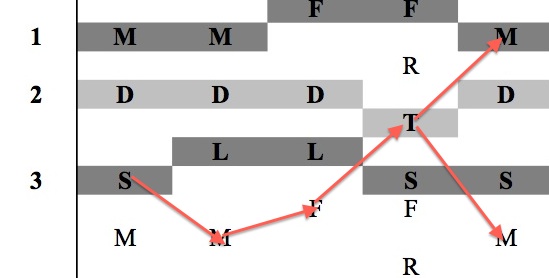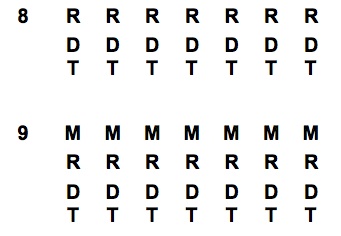The Sight-Singing Matrix
 via www.wired.comI taught an AP Music Theory class for three years. The class was a mix of band, orchestra and choir students (with the occasional guitarist thrown in for good measure). Some were planning on majoring in music in college; some were taking it to learn more about music; some, to be frank, took it because I cajoled them into it.
via www.wired.comI taught an AP Music Theory class for three years. The class was a mix of band, orchestra and choir students (with the occasional guitarist thrown in for good measure). Some were planning on majoring in music in college; some were taking it to learn more about music; some, to be frank, took it because I cajoled them into it.
Because the class had such a varied skill level regarding singing, I started at square one. Most of the choral students were good singers and had experience sight-singing, but not all of them did. Most of the band and orchestra students had minimal experience.
One of the things I used at the beginning of the year - and came back to occasionally as the year progressed - was a sight-singing matrix. This is used in the AP Vertical Teams Guide for Music Theory (a great book for your district's music department, even if you don't teach music theory), and we also used it during a summer workshop I took at Columbia College.
At first, they look confusing. There's some solfege written on a grid, some are bold, some are highlighted ... how do you make sense of it?
 I used this one frequently as a class warm-up before doing other sight-singing exercises.
I used this one frequently as a class warm-up before doing other sight-singing exercises.
Look at it vertically and horizontally - just like you would do when reading a chorale in standard notation.
Horizontally:
- The numbers here indicate the original pitches in the chorale this is based on (1 being the soprano voice, 2 being the alto, etc.).
- The shaded-in and bolded squares indicate the original line of the chorale.
Vertically:
- I filled in the chords, so each chord has all of the 1s, 3s and 5s that are available.
When you're using this with a class, you have a few straight-forward options:
- Students can sing one line in unison, and cycle through all four lines.
- Students can divide up and sing in 4-part harmony, singing the bolded lines
 But my favorite was giving the students the option to choose what they want to sing. A student could start on the pitch next to 3, but instead of following the bolded (original) line, she could sing "Sol - Mi - Fa - Ti - Mi."
But my favorite was giving the students the option to choose what they want to sing. A student could start on the pitch next to 3, but instead of following the bolded (original) line, she could sing "Sol - Mi - Fa - Ti - Mi."
As trained musicians, we know that this is an awkward line - strange leap at the end, atypical voice-leading. The student might not know this, but she'll learn that some things don't make sense, and have some experiences to relate to when you discuss melodic lines and voice-leading.
So not only are students learning solfege and learning to sight-sing without worrying about notation and rhythm, they are also learning about voice-leading and what can construct a good melody without, initially at least, worrying about the rules common-practice theory has.
Using a matrix can also help with introductory dictation exercises. I liked to start without rhythms, and I also liked to use worksheets that looked like this:

Students circle the pitches they hear. It might seem elementary, but it works remarkably well in getting students to translate what they hear into what they see.
As we got used to using a matrix, I would expand them, such as this one (from the AP Music Theory book references above) and this one. I would take chorales used in band or from other sight-singing books and rewrite them in Excel and put them on the overhead projector.
Let me know if you have any questions about sight-singing matrices! Feel free to use these examples I posted, and share some others that you come up with. I didn't come up with this idea, but I found it very useful and worthwhile in music theory classes.
Remember: a goal of music theory is to get our brains to see what we hear and hear what we see. The above matrices are but one excellent tool to help students achieve that goal.